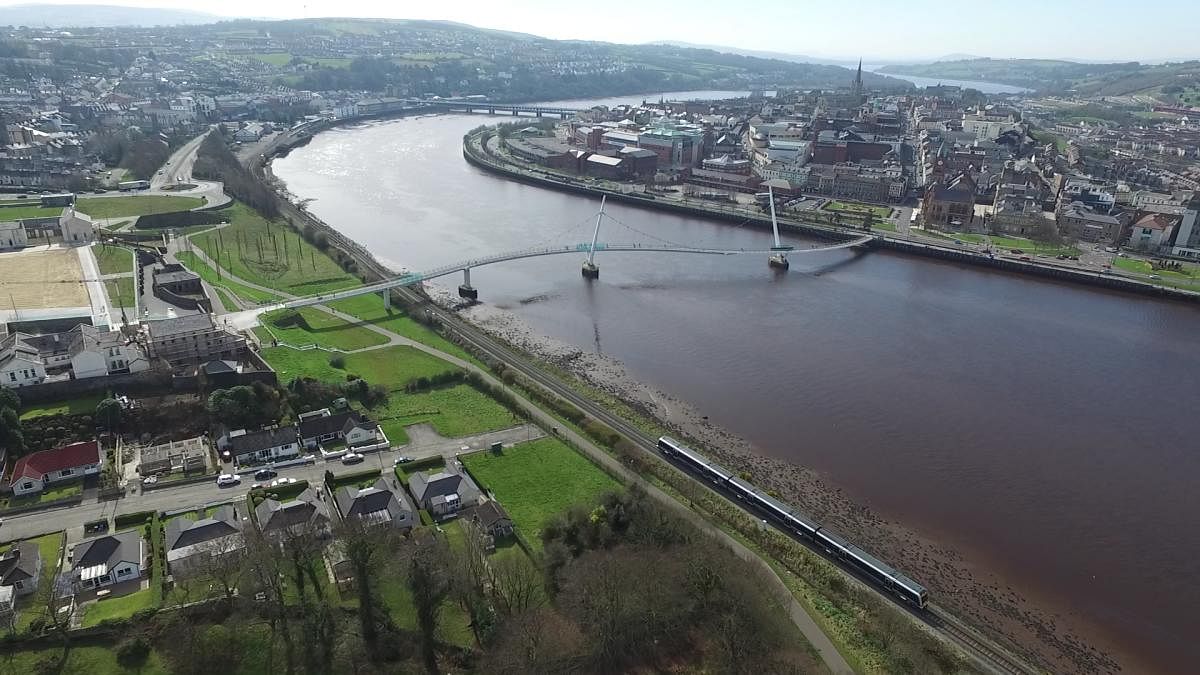

Despite the rains a few hours earlier, it’s a shade less than chilly. Well clad to beat the cold Derry weather, I step out of my hotel to enjoy the haloed Halloween air that the city gets enveloped in towards the end of October. A short walk takes me towards the piece de resistance of Londonderry (the other moniker of this city) — The Walls that encircled what was once the old city. These ramparts that boast a width ranging from 12 to 35 ft go back to the early 17th century. Any Derry denizen will proudly tell you that these walls, braving many a fierce battle, successfully kept all invaders at bay. Even during the 105-day siege of 1689, these walls kept the city impregnable — and that is how Derry got the title of ‘Maiden City’.
As the sky above gets awashed with a stunning palette of delightful hues, I stand next to a double bastion and look down the promenade that reveals an impressive sight. The walk along the 1.5 km ramparts takes me past seven entry points together with imposing bastions, watchtowers, battlements, and many fearful-looking restored cannons and mortars. I sit down close to one that goes by the name of Roaring Meg — so named because of the thunderous sound it made when blasted.
“Meg looks good, doesn’t she?” asks an elderly gentleman out on a walk as he stops for a chat. ‘Derr-eh’ (that’s the way the locals pronounce it), he says, is very proud of its history. “This includes not just The Walls and many later events, but also our Halloween celebrations. You’ll be part of them this evening,” he smiles pointing towards a young lad clad in a Count Dracula outfit, walking towards the centre of town. Going past a skeleton seated near one of the entry points, I move towards Derry’s buzzing marketplace. As loud celebratory music blares in the centre-of-town area, shops selling trinkets, Halloween wares, food, and drinks teem with activity. Every single person, across all age groups, seems dressed for the day dedicated to the dead.
Indeed, Halloween is a festival that the Irish believe originated from their land — Derry to be precise. Try talking about the Guy Fawkes and the American connection and they will tell you that Halloween’s origins in Northern Ireland go back to over a thousand years. According to local legends, the ghosts of the dead come back to Earth for a day on the ancient Celtic festival of Samhain that marked the end of harvest and the beginning of winter.
Since then, on Halloween, people start preparing and looking forward to some fun-filled encounters with ‘visitors’ from the Other World. In Derry, a special ‘Awakening’ evening (close to The Walls), is organised to offer a taste of folklore, festivity, music, and, yes, to enjoy scary moments with things macabre. Derry has been recognised as ‘Best Halloween Destination in the World,’ having taken over Salem in Massachusetts with its history of witch trials, and Transylvania, the home of Dracula.
The next morning, I walked towards the Museum of Free Derry that unfolds the history of the ‘Troubles’ era and its impact on the city. It takes you past the story of the civil rights movement and the creation of Free Derry in the 1960s and ‘70s. On the way, one comes across 12 murals depicting major political events/statements of the time. Made by local Bogside artists, these murals were a form of protest by the Catholics against the British policies and the lack of job and economic opportunities for them. The Rossville Street that shows up these murals was witness to the events of ‘the Bloody Sunday’ (January 30, 1972) when British tanks and guns were brought in to target unarmed people who were part of a civil rights march. It had been organised to protest the policy of indefinite detention and interrogation by the British military. A short walk that often makes you stop to admire the Irish landscape takes you towards the Derry Peace Bridge that stretches elegantly over the River Foyle. Opened in 2011, this beautifully designed ‘S’-shaped structure, also known as ‘Bendy Bridge’ looks like, as the locals will tell you, a huge steel snake when viewed from above. It was built to bridge the gap between the Protestants and Catholics who lived on either side of the river.
Travel alert
Those travelling to Ireland from India need to fill out a passenger locator form before departure.
If you have valid proof of vaccination (Covishield) or have recovered from Covid-19 in the past 180 days, no travel-related testing or quarantine will be necessary. For those with neither, evidence of a negative result from an RT-PCR test taken within 72 hours prior to arrival into Ireland is needed. Or, you will need to self-quarantine for 14 days in Ireland. And if you receive a negative result from an RT-PCR test taken from day five onwards after arrival, you will be able to leave quarantine.